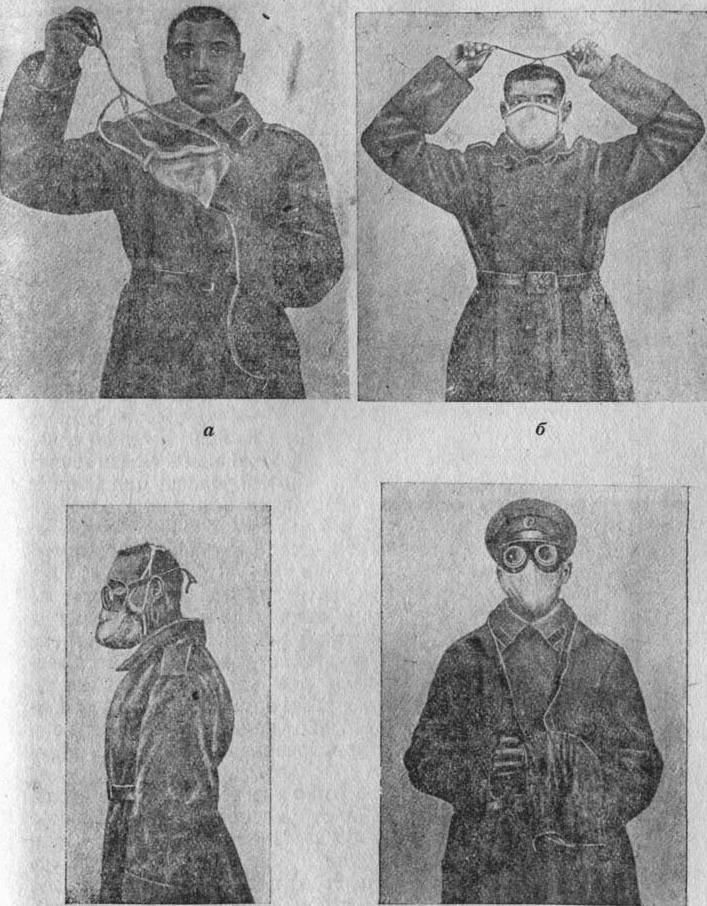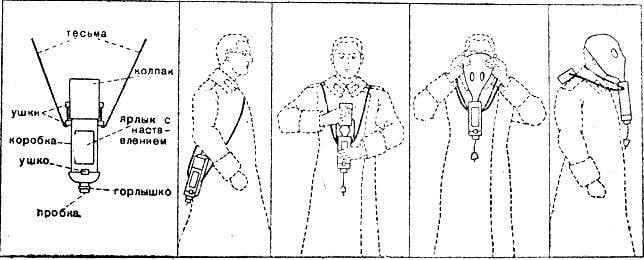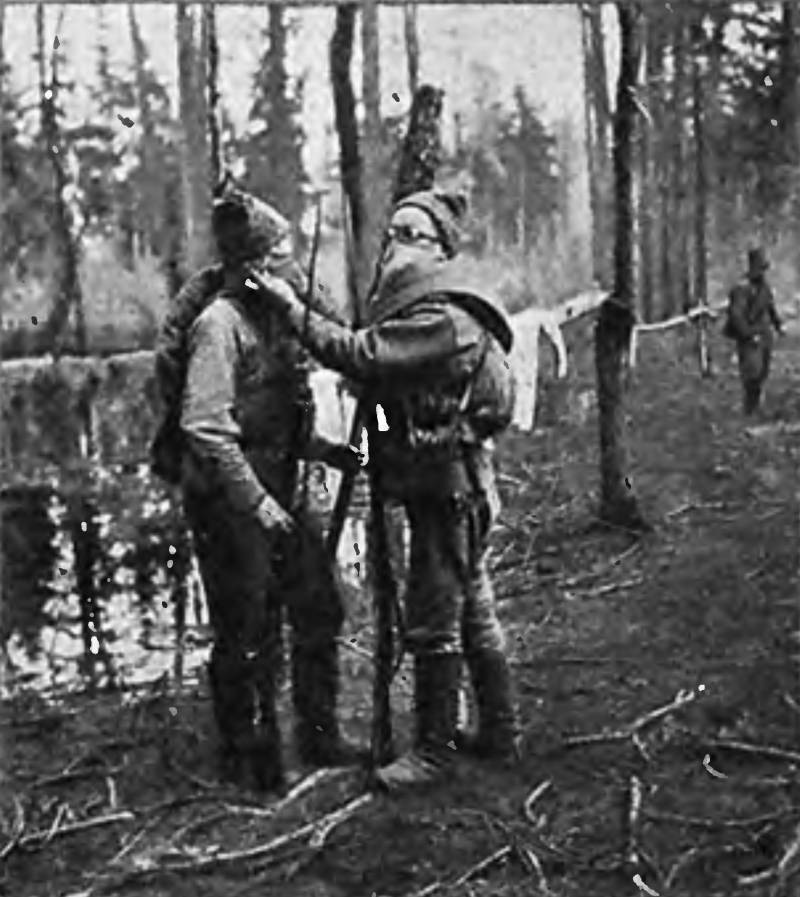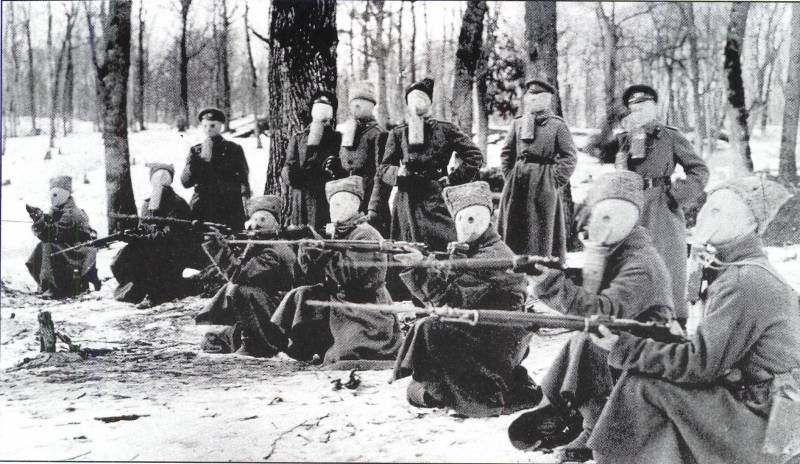"The gas vortex." Chemical war on the Russian front of the First World War. H. 2
Germans
22. 07. 1915 Germans inflict 2 mortar strikes (2000 mines each) - using chemical munitions against Russian troops on the front between Lomza and Ostrolenka.
09. 02. 1917, the Germans attacked the village. Batkuv Zvyzhzhen. The 3-I battery of the Russian 3-th artillery brigade, shooting at enemy enemy infantry chains, was subjected to a half-hour hurricane fire with chemical shells. Calculations began to wear gas masks in a poisoned atmosphere.
Over the next few days, the entire personnel of the battery (35 man) gradually applied for medical assistance - despite the use of gas masks by artillerymen, who weakened the effect of the chemical shock.
27. 02. 1917. The Germans conducted an intensive reconnaissance in the area of the Khukali forest - der. Repellers. After the 3-hour chemical artillery preparation area was occupied by the enemy - an hour later, the reserves were beaten out with the support of artillery. The Germans continued shelling of the forest until midnight - and only up to 600 people were out of action in this area poisoned. Such losses were explained by the fact that the Russian companies that fell under the artillery chemical fire were confused, trying to quickly get out of the affected area.
06. 07. 1917, the Germans, preparing the attack, tried to paralyze the Russian artillery in the combat area at the village. Maniluvki. The 11 watch section was under a hail of chemical projectiles alternating with high-explosive shells. Russian gunners managed to wear gas masks. But with signs of poisoning 7 gunners were registered.
The Germans used the shooting of chemical shells on the system t. "Gas rectangles" - the shelling area was 200 - 300 m along the front and 400 - 500 m in depth.
21. 03. 1917 was used by chemical artillery shells (300 guns and 100 mortars) under the method of the German artillery authority of Colonel G. Bruchmüller during the attack of the Russian springboard on the river. Stokhod y dd Tobols - Rudka Chervishche (the so-called “Chervyshchensky bridgehead”), defended by 2 by the divisions of the 3 Army Corps with 103 guns. Austro-Germans seized a bridgehead, capturing more than 10 thousand people.
During the Riga operation 19. 08. 1917 The German 14 Bavarian, 2 Guards and 19 Reserve Divisions offensive supported 170 batteries and 230 large and medium mortars. German artillery used a large amount of chemical projectiles - primarily to neutralize Russian artillery. 3 - 4 hours German artillery led counter-battery chemical fire - and with large-caliber shells. Part of the Russian guns was destroyed, and the other thrown by gunners. Many calculations died of poisoning. And the Russian artillery fell silent for a whole day - which became the most important prerequisite for successful actions of the enemy at the crucial stage of the operation.
An eyewitness recalled the blue and corpses of infantrymen and artillerymen, dead horses that had become gassed from gasping.
The 12 Infantry Division suffered the heaviest losses among the Russian 186 Army units (3283 of 6575 people, and 742 of Ponevezhsky regiment died during the gas attack).
The Riga operation was the first experience of replacing a multi-day (and disturbing surprise) shorter (several hours) artillery preparation. The latter was based on the method of refined shooting and rejection of the complete destruction of artillery in favor of neutralizing it - through the large-scale use of chemical shells.
September 8 Germans conducted a similar chemical artillery strike at Jacobstadt (56 batteries).
October 14 was carried out so-called. "Big shooting of chemical mines" - Russian positions were attacked at Ozerka (South-Western Front). Opponent used 8 medium and 8 light mortars. At night, 1400 mines were released in an hour, and, according to German data, 2 Russian companies suffered great losses.
Russian
22. 08. 1916, acting on the Lviv direction in der. Lopushany 6-th battery The 3-th artillery brigade conducted a counter battery chemical struggle with the enemy's 150-mm howitzers. 157 “red” shells were spent — and the enemy’s 150-mm battery “disappeared” from the position.
Began to apply combined chemical shock.
14 March 1917 was hit by chemical shells on the Austrian cavalry corps under Covel, and then several waves of chlorine were released.
On April 2 the Russians attacked the German 107 Infantry Division at Kuhara (south-east of Kovel). 4 chlorine-phosgene waves released in 5 hours. 10000 shells were also used. Gases penetrated to a depth of 9 km.
The center of gravity of chemical warfare in 1917 is shifted to the plane of artillery chemical shooting.
Means of individual anti-chemical protection
In the competition of gas with anti-chemical protection, the development of not only collective and individual means of protection, but also a clearer organization of the chemical service, as well as chemical discipline of the troops, was of great importance. But the development of individual chemical protective equipment (gas masks) was of paramount importance (see also Chemical protection on the French front).
Germans
The first, so-called. the gas mask-pincushion was imperfect, not guaranteeing losses from the advance of the infantrymen behind the gas wave - as happened, for example, when attacking 24. 07. 1915 Osovets. And in the first half of 1915, a new gas mask (mask and filter cartridge with corundum or pumice stone) was put into service in the summer, becoming the main until the end of the war. A gas mask (“linear” military-type protective mask) was invented and manufactured by the chemical department of the Prussian military ministry in conjunction with the Physical and Electrochemical Institute of the Emperor Wilhelm.
The German gas mask of the 1915 model was a half mask, covering at the same time the mouth, the nose and the eyes. She lay against her face along the line running through her forehead, temples, cheeks and under her chin. Everyone who received a gas mask should have customized it individually.
The gas mask consisted of a piece of cloth (casing) and a screw-in filter (cartridge). The platband was made of gas-tight cotton fabric, rubberized on one side. Glasses - from unbreakable and fireproof cellon. Two large folds in the form of bags on both sides of the glasses allowed you to enter the index finger under the mask and wipe the sweaty glasses. Cellon glasses were embedded in metal frames that were attached to the mask fabric with linen ribbon. Similarly, the metal ring was fastened into which the cartridge was screwed. The snug fit of the mask to the face was provided with elastic rubber bands, which were held at the temples and covered the back of the head. The tape hung on the neck allowed to wear a gas mask on the chest.
When choosing a place to place a filtering substance (absorber), the Germans believed that the filter should be a separate part that would be attached to the casing so that it could be easily removed and changed. The desire to avoid the need to change the mask itself, replacing only the cartridge, played a role. The “filter cartridge” contained absorbing substances located in the appropriate sequence between the hard wire meshes. The screw-on cartridge could be changed without the need to replace the casing. The contents of the cartridge consisted of grains of diameter 2-3 mm (porous stony substance - diatomite or pumice), impregnated with a solution of potash. Wet grains were also sprinkled with crushed absorbing coal.
Fitting a “linear mask” issued to the troops with hemmed edges was sometimes not a very easy thing. It was especially difficult for people with thin faces and sunken temples. This deficiency was eliminated already in the winter of 1915 - 16 by introducing a new “frame mask”. The thickened edge of the linear mask was replaced by a special cloth frame 2 cm wide and a few millimeters thick - sewn to the inner edge of the casing. Thus, the frame ensured the impermeability of the line of contact of the mask with the face. Equipped with a three-layer cartridge sample 1916 g. Introduces a new cartridge - so-called. "Three-layer", containing three layers of absorbers. Front half volume in 105 cube. cm contained 66 gr. the same chemical as the single-layer cartridge. Adjacent to it is the middle layer - from 36 gr. absorbing coal from coniferous wood, processed by a special process and having the ability to absorb substances such as phosgene. The top layer, volume in 45 cube. cm, located closest to the mouth of the owner of the gas mask, consisted of 15 g diatomite or pumice soaked with methenamine. The absorption of phosgene by the cartridge proceeded in such a way that at first most of the phosgene was mechanically absorbed by the middle layer, and then its residues were chemically decomposed by the upper layer.
Introduction to a three-layer gas mask of a special coal layer was of great importance. Coal absorbed such toxic substances as, for example, chloropicrin.
In 1917, when chloropicrin was used more and more, the coal layer was reinforced by the lower layer (cartridge 11-С-11). In 1918, the bottom layer was removed, and all the free space in the 185 cube. cm was set aside for absorbing coal - in the amount of 58% (cartridge Sontag). At the same time, the resistance of the cartridges to hydrocyanic acid was increased.
In June 1916, cartridges with low breathing resistance appear.
A special case for a gas mask also appears - a simple round tin with a hinged lid, which, unlike the old way of wearing, allowed the fighter to constantly carry a gas mask with a screwed-in chuck and put it on for a few seconds. The case was worn on a belt around the neck.
Significant improvements were made to the German gas mask in 1917. The steel casing was made of leather impregnated with a gas-tight compound. The reason: on the one hand, due to difficulties with raw materials, there was a shortage of rubber (and only a lower quality regenerated product could be used to soak the casing), on the other hand, the rubberized cotton fabric was not strong enough.
The German gas mask, especially leather, was ingeniously constructed and reliable.
Russian
In the summer of 1915, the so-called "Protective dressings". These were dressings made of gauze soaked in hyposulphite and glycerin. In addition to them, each fighter had with him a small tin of water for wetting gauze. German gas balloon attacks soon demonstrated the inadequacy of such protection. Sometimes they resorted to gas masks of French and English production, used captured samples.
3. Gas mask. Chronicles of the War 1914-15-16 No. 106.
One of the most remarkable inventions during the First World War, which saved the lives of thousands of Russian soldiers and officers, as well as allied soldiers and officers, was the creation of a coal gas mask. The honor of this invention belongs to the Russian academician N. D. Zelinsky, who was a student of the great DI Mendeleev. The author himself assessed the creation of a gas mask as the most important thing in life.
4. Officers and soldiers of the life guards of the Finnish regiment in gas masks Zelinsky. Winter 1916. Gorokhov J. Russian Imperial Guard. M., 2002.
In June 1915, Mr. N. D. Zelinsky, discovered that coal is a powerful absorbing agent. Charcoal had the most absorbent properties. The choice fell on birch. Birch charcoal was turned into activated charcoal - so on. its absorption properties were multiplied.
In the summer of 1915, he conducted an experiment on himself: wrapping a handkerchief around 50 of crushed activated birch coal, pressing a handkerchief to his face and closing his eyes, the scientist could be in the atmosphere poisoned by chlorine and phosgene for several minutes.
The first gas masks were created in August of the same year.
Faced with the rejection of his invention by the sanitary leadership of the Russian army (who lobbied for anti-gas masks) N. D. Zelinsky sent a personal letter to the Supreme Commander - the Emperor.
03. 02. 1916 in the Stavka on the personal order of the Emperor were organized tests of all masks and gas masks - both Russian and foreign. A laboratory car full of poisonous gases was attached to the imperial train.
Assistant-laboratory assistant N. D. Zelinsky in a new gas mask was able to stay in the chloride-phosgene atmosphere for over an hour (other samples of protective masks could not stand for more than a few minutes).
And with the blessing of the Emperor, the gas mask was introduced into the Russian army and began to save the lives of Russians, and subsequently Soviet soldiers and officers.
During the 1916-17. More than 11 million gas masks Zelinsky was released.
As stated in the instruction of military times, the gas mask protected against all known asphyxiating gases, used both “in the form of a cloud” and in projectiles.
The gas mask consisted of a special rubber mask (it tightly covered the face and head and was fitted with eyeglasses) and a tin box. The box could have been tetrahedral (Petrograd sample) or oval (Moscow sample is long; a sample of a state-owned factory is short). The mask was a helmet (hood) of a very good para-rubber, into which a chin and face were inserted and then pulled over the head. Glass (subsequently Cellon) glasses were inserted into the eye openings. For wiping misted glasses, gas masks had special folds or a rubber finger. The box contained specially treated activated carbon. The mask was tightly connected to the box - the air inhaled by the fighter, passing through the box, was neutralized. The box had a lid - in it, to protect from damage, put a mask. The filter cartridge was a rectangular tin - air entered through a round hole in the bottom of the box. The absorber consisted of pure charcoal (weight in old 150 samples, and in new ones 230 gr.). Resistance to the breathing of Russian gas masks was 4 - 5 mm, sometimes even 3 - 4 mm, that is, it was very small. In the German cartridge with low breathing resistance, it was equal to 4,5 - 6 mm.
The gas mask was worn over the shoulder, and the hole from the bottom of the box, to protect it from dampness, was prescribed to be tightly plugged with a stopper.
The documents noted the simplicity of the design of the gas mask and the cheapness of its box.

5. Stage donning gas mask - "stigma". Figurovsky N. A. Essay on the development of the Russian gas mask during the imperialist war 1914 – 1918. ML, 1942.

6. Wearing and donning a mask Zelinsky. From the leaflet attached to the first samples of the gas mask. Ibid.
Another type of Russian gas mask, which received less distribution, was called the "gas mask of the Mining Institute." He was significantly worse than the first (breathing resistance reached 22 mm). In appearance, he was different from the Zelinsky-Kummant gas mask in that his patron was an oval tin with flat edges, and that he was equipped with breathing valves. Finally, the mouthpiece of the oxygen breathing device was inserted into the mask. Box contained 225 - 300 gr. blends of soda-lime charcoal in proportions 1: 2 or 1: 3.
After the loss of technical surprise, the infantry attacks following the gas clouds were no longer successful. If the attacking infantry moved too fast, then it fell into its own gas cloud or under the fire of enemy artillery (to which the cloud had not yet reached). Therefore, the cloud was expanded by releasing non-toxic smoke clouds — simulating gas clouds. Then the enemy was forced to distribute his defensive fire over a longer stretch of the front and, consequently, spend more ammunition, and the infantry could be moved into the attack, hiding it behind or inside the smoke cloud. These smoke clouds covered the flanks of the infantry from the flanking fire of the enemy artillery. But the attack after the gas cloud was hampered not only by artillery, but also infantry fire of the enemy. The defender always remained in the ranks, though poisoned, but courageous people who could repel the attack with machine-gun fire. In addition, with modern gas masks and good chemical discipline, the gas balloon attack eventually ceased to cause the enemy losses. Thus, the attack following the gas launch, no longer yielded significant space gains. Therefore, they began to use gas releases solely with the aim of disturbing the enemy and causing him losses.
Successful was the use of a mixture of chlorine and chloropicrin - due to its lower volatility, it allowed a longer poisoning of the terrain than the mixture of chlorine with phosgene, and therefore could be used after abandoned infantry attacks.
From April 1915 to September 1917, the Germans conducted on various fronts around the 50 gas cylinder attacks. The amount of toxic substances required for this is 300000 (autumn 1917) - 500000 (autumn 1916) kilograms per month.
Russian troops steadfastly repelled the chemical attacks of the enemy - despite the heavy losses, leaving no positions (like their allies on the French front) and preventing the enemy from achieving operational and tactical success, exploiting the results of their gas attacks.
It became clear that the success of the fight against poisonous substances, above all, depended not only and not so much on the supply of troops with individual means of chemical protection, but also on the ability to deal with the latter. And in 1915-1916. Corresponding instructions and instructions appear in the Russian army, and instructors sent to the troops — the latter practically trained the personnel in the "gas mask case".


Information